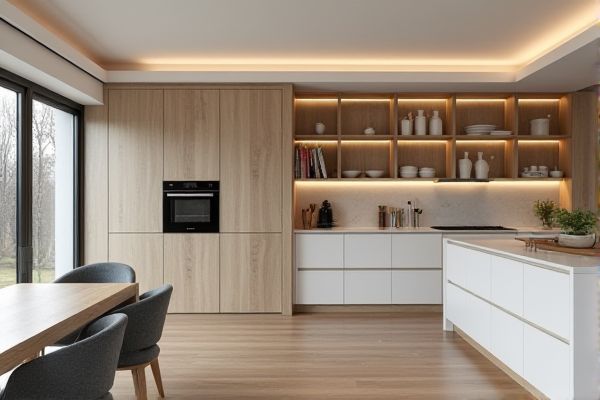
Choosing between an integrated pantry and a separate pantry room depends on your kitchen size and storage needs, as integrated pantries save space while separate pantry rooms offer more extensive storage and better organization. Discover which pantry style best suits your home by reading the rest of the article.
Table of Comparison
| Feature | Integrated Pantry | Separate Pantry Room |
|---|---|---|
| Space Requirement | Minimal, fits within kitchen layout | Requires dedicated room or space |
| Accessibility | Easy access during cooking | May require walking to another room |
| Storage Capacity | Limited to kitchen cabinetry size | Large, can store bulk and appliances |
| Organization | Basic shelving and cabinets | Custom shelving, better categorization |
| Cost | Lower installation and maintenance cost | Higher build and upkeep expenses |
| Design Impact | Blends with kitchen aesthetics | Separate design element, flexible style |
| Ventilation | Depends on kitchen ventilation | Independent ventilation system |
| Ideal For | Small to medium kitchens, limited space | Large homes, extensive storage needs |
Introduction to Pantry Design Concepts
An integrated pantry combines storage seamlessly within the kitchen layout, maximizing space efficiency and accessibility, whereas a separate pantry room offers dedicated storage that can accommodate bulk items and larger appliances. Your choice depends on kitchen size, lifestyle needs, and the importance of maintaining visual clutter or creating a distinct zone for food preparation. Effective pantry design balances convenience, organization, and workflow to enhance overall kitchen functionality.
What Is an Integrated Pantry?
An integrated pantry seamlessly blends into the kitchen design, utilizing built-in cabinetry and concealed storage to maximize space efficiency without disrupting your kitchen's aesthetics. Unlike a separate pantry room, which is a distinct, often larger area dedicated solely to storage, an integrated pantry offers easy access to essentials while maintaining a streamlined look. Your choice between these options depends on your kitchen layout and storage needs, balancing convenience with available space.
What Is a Separate Pantry Room?
A separate pantry room is a dedicated space designed exclusively for storing food, kitchen supplies, and small appliances, often located adjacent to or near the kitchen. This type of pantry offers ample storage capacity, improved organization, and easy access, minimizing clutter in the main kitchen area. Separate pantry rooms enhance kitchen functionality by providing a distinct area for inventory management, reducing cooking time and increasing efficiency.
Space Efficiency: Integrated vs Separate Pantries
Integrated pantries maximize kitchen space by blending storage seamlessly into cabinetry, ideal for smaller kitchens or open-plan layouts where every square foot counts. Separate pantry rooms offer extensive storage capacity and better organization for bulk items, but require additional square footage that may reduce overall kitchen space efficiency. Your choice should balance available space and storage needs, with integrated pantries providing compact efficiency while separate rooms serve larger households seeking extensive food storage.
Storage Capacity Comparison
An integrated pantry typically offers limited storage capacity as it is built into kitchen cabinetry, making it ideal for smaller kitchens or minimal storage needs. A separate pantry room provides expansive storage space, accommodating bulk items, large appliances, and extensive food supplies, which maximizes organization and accessibility. Your choice depends on the available space and storage requirements, with separate pantry rooms providing superior capacity for larger families or avid cooks.
Organization and Accessibility
An integrated pantry offers streamlined organization by combining storage directly within the kitchen space, allowing for quick access to frequently used items and reducing movement during meal preparation. In contrast, a separate pantry room provides expansive storage options with clear categorization and ample shelving, enhancing overall organization but requiring more effort to access ingredients. Both designs improve kitchen functionality, with integrated pantries emphasizing convenience and separate pantry rooms prioritizing comprehensive storage capacity.
Aesthetics and Home Design Impact
An integrated pantry enhances kitchen aesthetics by providing a streamlined, cohesive look that maximizes space efficiency and blends seamlessly with cabinetry, contributing to a modern, minimalist home design. In contrast, a separate pantry room offers greater flexibility for storage organization and reduces kitchen clutter, but it requires additional square footage and can interrupt open-plan layouts. Choosing between the two impacts the overall flow, visual harmony, and functional zoning of the living space.
Cost Considerations
Integrated pantries typically cost less due to reduced construction and material expenses, relying on existing kitchen cabinetry and space. Separate pantry rooms involve higher costs from additional framing, electrical, lighting, and possible ventilation requirements. Homeowners must weigh budget constraints against desired storage space and convenience when deciding between these pantry options.
Suitable Home Layouts for Each Option
Integrated pantries work best in open-concept kitchens and smaller homes where maximizing space is crucial, seamlessly blending storage within existing cabinetry. Separate pantry rooms suit larger homes with more square footage, offering dedicated storage that can accommodate bulk items and enhance organization without disrupting kitchen aesthetics. Your choice depends on available space and your preference for accessible storage versus a distinct, organized area.
Choosing the Best Pantry Solution for Your Needs
An integrated pantry maximizes space efficiency by blending seamlessly with kitchen cabinetry, ideal for smaller homes or those seeking streamlined storage. A separate pantry room offers expansive storage capacity and easier organization for bulk goods, perfect for larger kitchens or avid home cooks. Consider your kitchen layout, storage needs, and lifestyle to determine whether Your home benefits more from the compact convenience of an integrated pantry or the spacious functionality of a separate pantry room.
 homyna.com
homyna.com